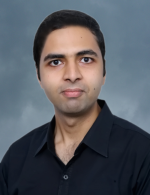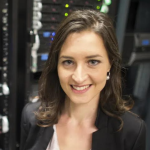NERSC Honors Early Career Researchers with 2022 Achievement Awards
October 24, 2022
At the 2022 Annual NERSC User Group meeting in October, NERSC announced the recipients of its annual High Performance Computing Achievement Awards, recognizing four early-career scientists who have made significant contributions to scientific computation using NERSC resources.
The NERSC awards pay tribute to the accomplishments of young researchers in scientific fields supported by the U.S. Department of Energy Office of Science. The awardees were cited for their pioneering work in a variety of fields, including astrophysics, genomics, and materials research.
Three awardees - Andi Gu, Chirag Jain, and Bin Ouyang - were honored for High Impact Scientific Achievement, while Giulia Palermo received the award for Innovative Use of High Performance Computing.
Andi Gu

Andi Gu
Gu, a quantum science and engineering Ph.D. student at Harvard University who earned a bachelor of arts in computer science and physics from the University of California (UC) Berkeley in May 2022, was recognized for his work developing and applying GIGA-Lens, a fast Bayesian inference tool used in strong gravitational lens modeling to enhance the study of dark matter. While at UC Berkeley, Gu worked with the Quantum Nanoelectronics Lab on campus and the Supernova Cosmology Project (SCP) at Berkeley Lab.
Xiaosheng Huang, associate professor of physics and astronomy at the University of San Francisco who leads the SCP strong gravitational lensing subgroup, nominated Gu for this award for his contributions to the project’s lens search and lens modeling efforts. “During the first year, he developed an improvement for our lens search neural network architecture. During the second year, he developed GIGA-Lens, both a TensorFlow implementation and a JAX implementation, capable of running on four GPUs on a single node,” Huang wrote in the nomination.
“Simply put, his work is exceptional,” added Saul Perlmutter, a professor in the physics department at UC Berkeley and leader of the SCP, in a letter supporting Gu’s nomination. “He has applied his creativity and problem-solving skills not only to his own projects, but to helping his teammates.”
Chirag Jain

Chirag Jain
Jain, who received his Ph.D. in computational science from the Georgia Institute of Technology in 2019, was honored for his work developing and applying FastANI, a computational method of measuring relatedness between two genomes. At Georgia Tech he worked closely with Prof. Kostas Konstantinidis, who heads the Environmental Microbial Genomics Laboratory at Georgia Tech and nominated Jain for the NERSC award. Jain is currently an assistant professor in the Department of Computational and Data Sciences at the Indian Institute of Science in Bangalore.
“Microbiologists are increasingly turning to whole-genome sequencing-driven mathematical approaches to address fundamental questions associated with ecology and diversity,” Konstantinidis noted in his nomination. “The FastANI method can be applied to finished or draft genomes, unfinished genomes which are only available as a set of long contiguous sequences, and incomplete genomes with sufficient gene coverage, making it broadly applicable.” In addition, the mathematical advancements underpinning the FastANI algorithm resulted in a fast, memory-efficient, alignment-free, approximate sequence-matching based method that yields pretty much identical results to universally accepted but computationally expensive alignment-based methods.
Bin Ouyang

Bin Ouyang
Bin Ouyang, who was honored by NERSC for advancing the understanding of chemical short-range order for designing a new generation of commercialized cathode materials, has more than five years of experience using NERSC resources since he was a postdoc at UC Berkeley and Berkeley Lab. He is now an assistant professor in the department of chemistry and biochemistry at Florida State University, where he is leading a group that utilizes high-throughput computation, machine learning, and data mining to develop and understand novel materials for energy storage and conversion. His computational efforts have led to 18 publications in the past three years and four U.S. patents.
“Bin is a computational theorist for the new age,” said Gerbrand Ceder, distinguished professor of engineering in the Department of Materials Science & Engineering UC Berkeley and Ouyang’s postdoc advisor, in a letter to the review committee. “He has the clarity of a physicist but the ambition to work on real-world materials problems of a materials engineer. He operates by first analyzing the fundamental issues in a technical problem, then attacking them with a range of relevant computational approaches, and finally heading back to the experimental people with suggested solutions.”
Giulia Palermo

Guilia Palermo
Guilia Palermo, who leads a computational biophysics lab in the department of bioengineering and chemistry at UC Riverside, was honored with the Innovative Use of High Performance Computing award for unraveling the mechanistic basis of CRISP-Cas9-mediated genome editing. At UC Riverside, her team applies computer simulations to characterize the mechanism of action of emerging genome editing systems, notably the mechanism of nucleic acid binding, specificity and catalysis of CRISPR-Cas9, a leading genome-editing system. Their multiscale approach harnesses molecular dynamics and multiscale modeling, quantum mechanical methods, and cryo-electron microscopy processing techniques.
“Our major accomplishments are the characterization of the dynamics and mechanism of CRISPR-Cas systems, which are large biomolecular complexes enabling facile manipulation of the genome, and other large macromolecular machines acting on genes,” Palermo stated. “We use large-scale molecular simulations, requiring state-of-the-art high performance computing architectures that are available through NERSC.”
“Giulia Palermo is an outstandingly dynamic and creative leader in computational chemistry and biology,” said J. Andrew McCammon, distinguished professor at UC San Diego and senior fellow at the San Diego Supercomputer Center, in a letter to the review committee. “She joined our group in early 2016 with her own Advanced Postdoctoral Fellowship Award from the Swiss National Science Foundation. She moved to the UC Riverside faculty in 2018 and has already established her group as a world leader at the frontier of computational chemistry and biochemistry.”
About NERSC and Berkeley Lab
The National Energy Research Scientific Computing Center (NERSC) is a U.S. Department of Energy Office of Science User Facility that serves as the primary high performance computing center for scientific research sponsored by the Office of Science. Located at Lawrence Berkeley National Laboratory, NERSC serves almost 10,000 scientists at national laboratories and universities researching a wide range of problems in climate, fusion energy, materials science, physics, chemistry, computational biology, and other disciplines. Berkeley Lab is a DOE national laboratory located in Berkeley, California. It conducts unclassified scientific research and is managed by the University of California for the U.S. Department of Energy. »Learn more about computing sciences at Berkeley Lab.







